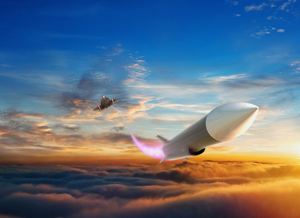Even after half a century of development efforts, the field of air breathing hypersonics continues to see breakthroughs.
With the latest developments in ramjets, scramjets and advanced solid rocket motors, the fastest missiles in the world are getting even faster and more capable. They’re more flexible, cost-effective and survivable than ever before.
Pushing Hypersonics Forward
The U.S. military’s recent interest in hypersonics “was born out of what our potential adversaries are doing, particularly Russia and China,” said Buzz Toth, director of strategy and business development for the Propulsion Systems and Controls operating unit at Northrop Grumman Defense Systems. “In order to compete, we need systems that are higher performing but also affordable.”
A number of key technologies are driving America’s hypersonics resurgence. Here are some of the highlights.

Ramjets
A ramjet engine is a key component of air breathing systems. It draws in air for combustion using just the forward motion of the missile and allows the missile to achieve exceptional speed with fewer moving parts, doing away with the compressor and the turbine.
“Recent advances in miniaturization have allowed for more flexible form factors,” Toth said. “Ramjets today can meet a range of sizing constraints depending on the specific military need.”
Scramjets
A variant on the ramjet, the supersonic combustion ramjet — or scramjet — operates at even higher speeds. Advanced materials and sophisticated modeling are making these engines ever more efficient.
“The higher the speed we’re operating at, the higher the temperatures become, the more important the need for advanced material solutions and advanced thermal management,” said Christopher Gettinger, director for the Advanced Propulsion and Systems operating unit at Northrop Grumman Defense Systems. “It’s all about maximizing the amount of thrust that you get out of the engine, maximizing the operating efficiency.”
Advanced Solid Rocket Motors
Hypersonic performance requirements are driving the need for improvements in solid rocket motors .
“We can pack more propellant into a given volume than we were able to in the past,” Toth said. “We have new propellant formulations that give us greater thrust. We have improved nozzle types that give you better performance, without all the thermal barrier coating required by older nozzle types. All this helps to improve performance.”

Sophisticated Approaches
Advanced engineering processes and sophisticated approaches to the hypersonic problem are helping to drive these advances. Additive manufacturing, a transformative approach to industrial production, is helping to make hypersonic solutions more cost effective. Meanwhile, advanced materials enable engineers to develop systems that can operate at higher temperatures. Sophisticated modeling and simulation can also speed the development processes while lowering cost.
“Along with advances in computational fluid dynamics, this enables us to do things today in terms of design that we couldn’t have done 20 years ago,” Toth said.
Hypersonics represent a complex engineering challenge. These are high-performing systems requiring careful thermal management. There are sophisticated power needs involved, while continued calls for miniaturization further complicate the picture. To tackle these challenges, Northrop Grumman brings a range of skilled experts to the table with a unique combination of skills.
“We can bring all the disciplines together — the power, the thermal, the performance,” Gettinger said. “By modeling and designing all of that together, by viewing the missile as a single system we’re able to get a higher-performing system that can go farther, carry more, and fit into a smaller package.”
At the same time, Northrop Grumman’s approach helps to bring ongoing innovation and creativity to a field that is already more than half a century in the making.
“It’s all about creating a culture where everybody has a say in the process, where everybody’s ideas carry weight. When you add to that an internal testing capability, we can allow people to put their ideas into action,” Toth said.
Looking ahead, the Northrop Grumman teams sees even more advances on the horizon.
“Soon we will be able to do things that simply weren’t practical or affordable in the past,” Gettinger predicted. “We’ll see levels of performance that go even further than what is available today.”